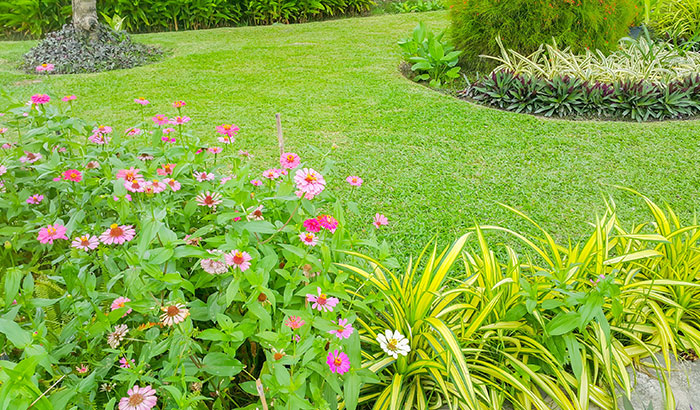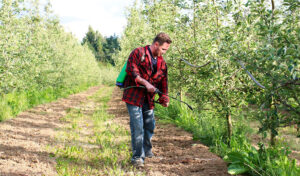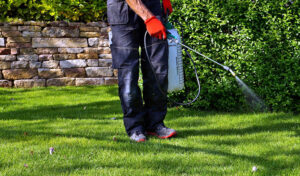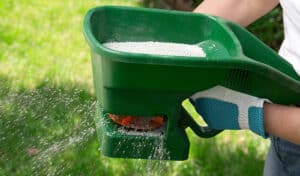Good lawn care practices provide a comfortable space to enjoy, increases your property’s value, and contribute to a cleaner and healthier environment.
Whether you’re a seasoned lawn enthusiast or a novice gardener, these tips will empower you to nurture a lawn that thrives in Utah County’s conditions.
Understanding the Utah County Climate and Soil
Utah County experiences a semi-arid climate characterized by hot, dry summers and cold winters. The region typically receives moderate precipitation, but water availability can vary seasonally. Understanding this climate is crucial as it directly impacts your lawn’s health and growth.
During scorching summer months, the lack of moisture and intense heat can lead to drought stress on lawns, causing them to turn brown and dormant. Conversely, winter temperatures can be harsh, potentially causing damage to the grass if not adequately prepared for the cold.
Utah County’s soils exhibit considerable variation, ranging from sandy to clayey textures. Each soil type has unique characteristics influencing water retention, drainage, and nutrient availability.
- Loam Soil: Considered the ideal soil type for lawns, loam is a balanced mixture of sand, silt, and clay. It provides good drainage while retaining adequate moisture and nutrients, offering an optimal environment for healthy root development.
- Clay Loam Soil: This soil type contains a higher percentage of clay particles, which can lead to waterlogging and poor drainage. However, it retains nutrients relatively well, making it fertile ground for grass growth.
- Sandy Loam Soil: Sandy loam consists of a higher proportion of sand, which improves drainage but reduces water and nutrient retention. Lawn care practices need to focus on maintaining soil moisture in sandy loam soils.
How Climate and Soil Affect Lawn Care Practices?
Understanding the climate and soil of Utah County is fundamental to tailoring your lawn care practices for success.
- Watering: Given the semi-arid climate, water conservation is essential. Lawns require deep and infrequent watering to encourage deep root growth, making them more resilient during dry spells.
- Soil Amendments: To improve soil quality, consider incorporating organic matter such as compost or well-rotted manure. This enriches the soil structure, enhances water retention in sandy soils, and improves drainage in clayey soils.
- Fertilization: Climate and soil type influence the timing and type of fertilizers you should use. Opt for slow-release or organic fertilizers to ensure a steady supply of nutrients throughout the growing season. Adjust fertilizer application rates based on your lawn’s specific needs, considering the soil’s nutrient-holding capacity.
Selecting the Right Grass Types for Utah County
Choosing the right grass varieties for your Utah County lawn is paramount to its success. Given the semi-arid climate, several grass types have proven to be well-adapted to the region’s conditions:
- Kentucky Bluegrass (Poa pratensis): This popular cool-season grass thrives in Utah County’s climate. It boasts a lush, dense appearance and can withstand foot traffic well. Kentucky Bluegrass requires adequate watering and benefits from proper soil preparation.
Advantages: Beautiful appearance, excellent self-repair capability, and high tolerance to moderate foot traffic.
Disadvantages: Requires more water and regular maintenance, less tolerant of heavy foot traffic.
- Fine Fescue (Festuca spp.): Fine Fescue is another excellent choice for a lawn in Utah county. It includes various species such as Chewings Fescue, Creeping Red Fescue, and Hard Fescue. Fine Fescue varieties are drought-tolerant, shade-resistant, and low-maintenance, making them ideal for a sustainable lawn.
Advantages: Drought-resistant, shade-tolerant, and requires less water and mowing.
Disadvantages: Slightly less heat-tolerant than other grass types, may not withstand heavy foot traffic.
- Turf-type Tall Fescue (Festuca arundinacea): Known for its adaptability to various soil types, Tall Fescue is a hardy grass type suitable for Utah County’s diverse soils. It can withstand heat and drought while maintaining a lush appearance.
Advantages: Drought-tolerant, adapts well to different soil types, and handles moderate foot traffic.
Disadvantages: Coarser texture than Kentucky Bluegrass, may require more frequent mowing.
Watering Practices for Utah County Lawns
Watering is a critical aspect of lawn care that directly impacts the health and appearance of your Utah County lawn. Proper watering ensures lush greenery, promotes a robust root system, and enhances your lawn’s resilience to drought and stress.
Insufficient watering can lead to brown patches and weak grass, while overwatering can result in shallow root growth, making your lawn susceptible to diseases and weeds. Striking the right balance is key to maintaining a vibrant and sustainable lawn.
Recommended Lawn Watering Schedule for Utah County’s Climate
In Utah County’s semi-arid climate, water conservation is essential. To optimize watering practices, follow this recommended lawn watering schedule:
- Watering Frequency: Water your lawn deeply but infrequently. Aim for 1 to 1.5 inches of water per week, including rainfall. Dividing the weekly water requirement into two or three watering sessions ensures the water penetrates deeply into the soil, encouraging deep root growth.
- Watering Time: Water your lawn early in the morning or in the evening to minimize water loss due to evaporation. Avoid watering during the hottest part of the day to prevent scorching your grass and wasting water.
- Irrigation Systems: If using an irrigation system, ensure it is functioning correctly and adjust the settings to deliver the recommended amount of water. Consider installing a smart irrigation controller that adjusts watering based on weather conditions to avoid overwatering.
- Rainfall Consideration: Monitor rainfall amounts and skip watering sessions if sufficient rain has fallen. Implement rain barrels to collect rainwater, providing an eco-friendly and cost-effective water source for your lawn.
Water Conservation Tips
In times of water restrictions or drought, conserving water becomes even more crucial. Follow these water conservation tips to comply with Utah County’s water restrictions and support sustainable lawn care:
- Xeriscaping: Consider xeriscaping or incorporating drought-resistant plants and landscaping features into your lawn design. This reduces the need for excessive watering while still maintaining an attractive outdoor space.
- Mulching: Apply a layer of organic mulch around plants and flower beds to retain soil moisture and reduce water evaporation. Mulching also helps control weeds that compete for water with your grass.
- Aerate the Soil: Regularly aerate your lawn to improve water penetration and reduce runoff. Aeration creates small holes in the soil, allowing water and nutrients to reach the grassroots more effectively.
- Adjust Sprinkler Heads: Ensure your sprinkler heads are correctly aligned and not watering sidewalks or driveways. Redirect the water to target the lawn precisely, avoiding wastage.
Fertilization and Soil Amendments
Fertilization plays a vital role in providing essential nutrients to your lawn, ensuring it thrives and maintains its lush, vibrant appearance. Grass requires a balanced diet of nitrogen, phosphorus, and potassium (N-P-K), along with other micronutrients, to support healthy growth and resilience.
Suitable Fertilizers for Utah County Lawns
In Utah County, where soil types and climate vary, selecting the right fertilizer is crucial for the optimal health of your lawn. Consider the following types of fertilizers:
- Complete N-P-K Fertilizers: These fertilizers contain a balanced blend of nitrogen, phosphorus, and potassium, represented by three numbers on the package, such as 10-10-10 or 20-5-10. Complete fertilizers are suitable for general lawn maintenance and provide a well-rounded nutrient supply.
- Slow-Release Fertilizers: Slow-release fertilizers gradually release nutrients over an extended period, offering consistent nourishment to your lawn. They reduce the risk of over-fertilizing and ensure a steady supply of nutrients to support long-term growth.
Organic Options
Organic fertilizers enrich the soil with organic matter, enhancing its water retention capacity, a crucial aspect in semi-arid regions. Additionally, organic options improve soil structure, encouraging aeration and beneficial microbial activity.
Aeration and Dethatching
Lawn aeration and dethatching are essential practices that contribute significantly to the health and vitality of your lawn in Utah County. Let’s explore the benefits of each.
Lawn Aeration
- Enhanced Soil Aeration: Aeration involves perforating the soil with small holes to improve air circulation, water penetration, and nutrient absorption. This encourages deeper root growth and better overall health of the grass.
- Reduced Soil Compaction: In high-traffic areas or heavy clay soils, compaction can restrict root growth and water movement. Aeration alleviates soil compaction, allowing roots to access essential nutrients and water more effectively.
- Enhanced Fertilizer Absorption: After aeration, fertilizers can better reach the grassroots, maximizing their effectiveness and promoting vigorous growth.
Dethatching
- Thatch Removal: Thatch is a layer of dead grass, roots, and debris that accumulates on the soil surface. While a thin layer of thatch can be beneficial, excessive thatch buildup hinders water, nutrients, and air from reaching the soil and roots.
- Improved Water and Nutrient Absorption: Dethatching enables water and nutrients to penetrate the soil and reach the grassroots, promoting a healthier and more resilient lawn.
- Reduced Pest and Disease Incidence: Thick thatch layers can harbor pests and diseases. Removing thatch minimizes potential pest habitats, leading to a less favorable environment for lawn issues.
Winterizing Your Lawn
Winter in Utah County brings unique challenges to lawn care due to its cold and often snowy conditions. Proper winterization is essential to protect your lawn during the colder months and ensure a healthy resurgence come spring.
Lawn Care Tips for Winterizing
- Late Season Fertilization: Before winter sets in, apply a winter-specific fertilizer higher in potassium (the third number in the N-P-K ratio). Potassium enhances the grass’s ability to tolerate cold and disease while promoting root growth.
- Mow at the Right Height: Lower the mowing height slightly for the final mow of the season. However, avoid scalping the lawn, leaving it vulnerable to winter stress.
- Remove Leaves and Debris: Keep the lawn free of leaves, branches, and other debris to prevent smothering and potential disease issues.
- Aerate the Lawn: If you didn’t aerate earlier in the year, consider aerating the lawn in the fall to relieve soil compaction and improve water and nutrient penetration.
- Continue Proper Watering: Adequate watering is essential until the ground freezes. Ensure the lawn is well-hydrated in winter, but avoid overwatering to prevent ice formation.
- Snow Removal: When shoveling or snow blowing, avoid piling snow on the lawn, as this can lead to snow mold and cause damage to the grass.
Get the Best Lawn in Utah County with Summit Lawn and Pest Control
At Summit Lawn and Pest Control, we understand the importance of maintaining a healthy and disease-free lawn to achieve the lush, vibrant landscape you’ve always dreamed of. Our team of skilled professionals is dedicated to providing effective prevention and treatment solutions for lawn diseases, ensuring your lawn remains in top condition.
Don’t let lawn diseases compromise the beauty and health of your landscape. Contact us today at 801-473-9926 for lawn care tips and personalized consultation.







